Most Wanted 2021



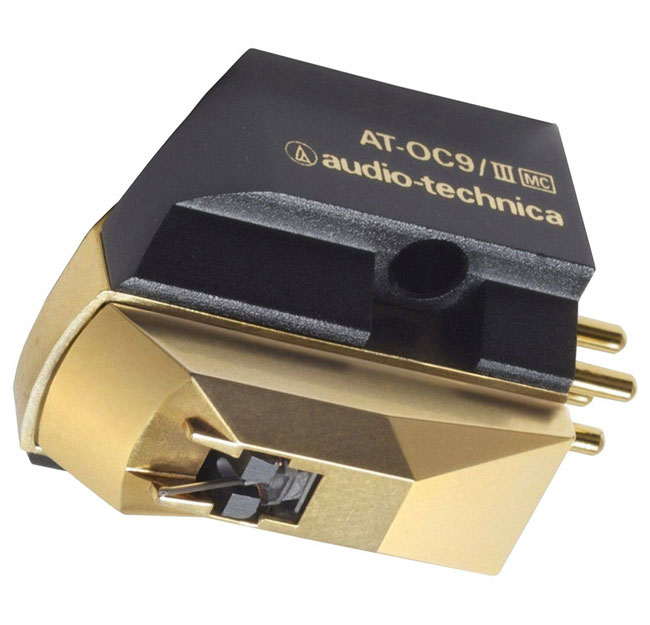
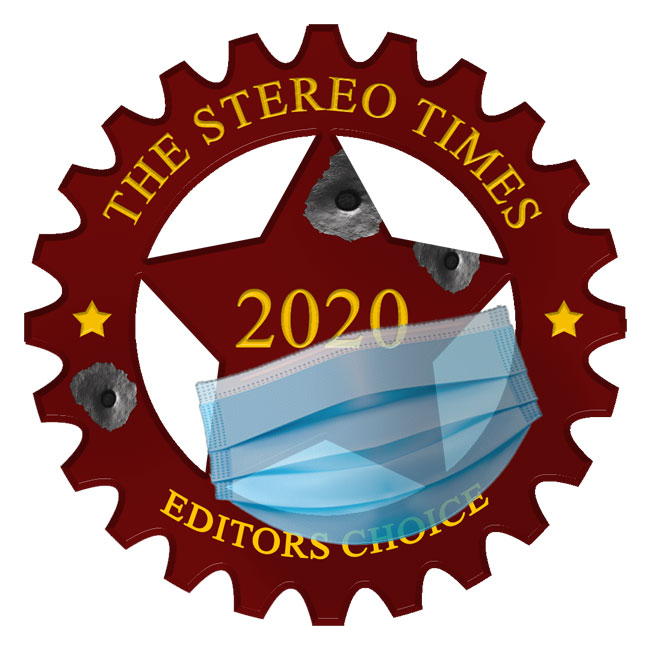
Audio Technica AT OC9 XSL MC Cartridge ($729 Reviewed here): At the top of Audio Technica’s OC9 low-output moving-coil cartridge line, the $729 XSL offers an uncompromised level of sonic detail coupled to equally non-compromised musical communication. Demanding of high tonearm quality and extremely conscientious SRA alignment, the OC9 XSL challenges much higher priced cartridges in performance and does it at a rational price. A breakthrough, I’d call it. (Paul Szabady)


Charisma Audio Musiko Tonearm ($2,500.00 reviewed here): The Musiko is a fabulous unipivot design that confidently tracks the grooves of your records and makes you feel as though you are getting everything that your recordings have to offer. It is elegantly designed and built and looks and performs as though it would be right at home on a mega-buck table such as the Continuum Caliburn or a modestly priced table like the G.E.M. Dandy Polytable that I used with it. If you’re devoted to vinyl and want to upgrade to an arm that gives you a significant portion of what you can get from arms like the Graham and Basis, you’d do well to look into the Musiko before plunking down easily 3-4 times the money. (Dave Thomas)


G.E.M. Dandy Polytable ($1,495.00 reviewed here): At a time when many turntable builders seem to feel it is best to make them bigger, bolder, pricier, and built with ridiculous amounts of exotic materials, legendary turntable designer George E. Merrill is taking a different approach. His minimalist designed G.E.M. Dandy Polytable removes as many unnecessary materials from the table as possible to make sure that the table makes an as little negative impact on the information pulled from the grooves of your records. The result is music that is closer to the truth of the recording. In other words, less is more. Less material equals more music. And relatively speaking, whole lot less negative impact on your bank account. Paired with a well-executed and reasonably priced arm like the Charisma Audio Musiko or Sorane SA-1.2 and you’ll have yourself a giant-killer of an analog front-end. (Dave Thomas)

Koetsu Coralstone Platinum cartridge ($14,995): Frankly, there aren’t that many new products in the market that have captured our collective imaginations for some time now. Most designs are rehashed from past catalogs and most are rather boring.
But one product stands head and shoulders above the rest of them. It is the Koetsu Coralstone Platinum cartridge. New, more expensive, more advanced cartridges have been released but the Koetsu more than holds its ground. Not many can touch its sheer tonal beauty and ability to portray a musical event as real and live. Gone are the days when Koetsus were blamed for tubby bass and rolled off highs. These platinum stone bodied carts do dynamics and frequency response as well as any other high end cart you can think of. Midrange, of course, remains it’s key magical quality. It is to die for. And for a design that’s many decades old, that’s saying a lot. (Stephen Yan)

Origin Live Discovery 2 MM/MC Phono Stage (Reviewed here): Priced just below $2000, the Origin Live Discovery 2 offers levels of ultra-resolution, ultra-dynamics, and ultra-musical performance that invites incorporation into the highest resolution systems. Able to handle any cartridge type, the Discovery 2 extends Origin Live’s legendary wizardry in State-of-the-Art turntables and tonearms to the phono stage. An ultra-performing phono preamplifier at a definitely non-ultra price. (Paul Szabady)


Origin Live Gravity One Record Weight (just under $200 reviewed here): Origin Live’s lightweight, ultra-sophisticated record damper cuts the workload on the cartridge and tonearm by damping the mechanical energy generated into the record by the physical forces of stylus tracking. The result is freedom from spuriously generated energy that allows a purer rendition of the musical signal. Expect a big increase in naturalness, fidelity, and low-level dynamic resolution and detail, plus the elimination of false brightness, edge, and distortion of the natural harmonics of instruments. More of an essential than a turntable accessory, the Origin Live Record Weight sets the standard for effective resonance control and comes with a no-risk money-back guarantee.(Paul Szabady)

PS Audio Stellar Phono Preamp ($2,499.00 reviewed here): PS Audio’s Stellar Phono combines great, detailed, ear-pleasing sound and an ease of use few of its competitors can match. It’s remote provides a wonderfully thought out user experience, allowing the you to change settings from a distance. The Stellar Phono offers two remote-switchable inputs (MM and MC) – to serve two turntables or a table with two arms. (Greg Voth)

Vincent Audio Phono Stage PHO-300 ($349.00 reviewed here): This compact unit is comprised of a phono stage and a separate power supply which gives this product a small and tidy footprint. The sonics were excellent with vinyl playback. It works flawlessly with Vincent Audio amp products or other manufactured units that can benefit from an outboard phono stage. It performed well above my expectations, Its usability and its clean design aesthetic make this unit very accessible for the investment. Bravo to Vincent Audio a key player in the audio field. (Tim Barrall)



Aric Audio Motherlode MK-II Preamplifier ($4,795): The Motherlode-MKII is a two chassis 6SN7 based, tube rectified, flagship model represents Aric Kimball’s all-out assault on building the finest vacuum tube line-stage that he could, regardless of cost. Besides the beauty of the exterior woodwork on the two-box chassis and premium internal parts, this preamplifier offers gorgeous timbres, holographic imaging, a black noise floor, and reference level speed/slam, which often is the weak link when using tubes in a preamplifier. Review coming. (Terry London)

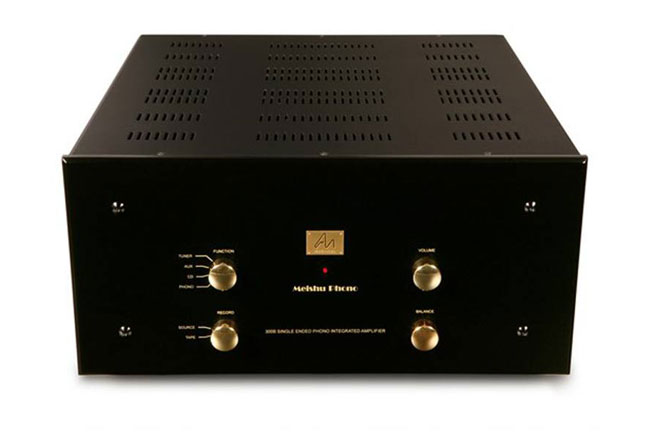

Audio Note Tonmeister Meishu Phono Integrated (starting at $10,995): Miles Davis’s 1963 classic recording of Seven Steps to Heaven haunts me when I first turned it up on this 8-watt, 300-B musical maestro. It ever-so-gently drove my 98 dB sensitive Tekton Double Impact SE’s with a level of harmonic rightness I experienced only from the finest transducers. Not sure how this beginner’s level design could reach such lofty musical heights (the Jinro, Tomei, and Ongaku are its more expensive relatives), creating such a realistic and sincere attempt at realism. The Audio Note AN-SPe/HE loudspeaker is being prepared to match up with the Meishu very shortly to complete the Audio Note experience here. I shall have much more to share in my upcoming review so stay tuned. (Clement Perry)

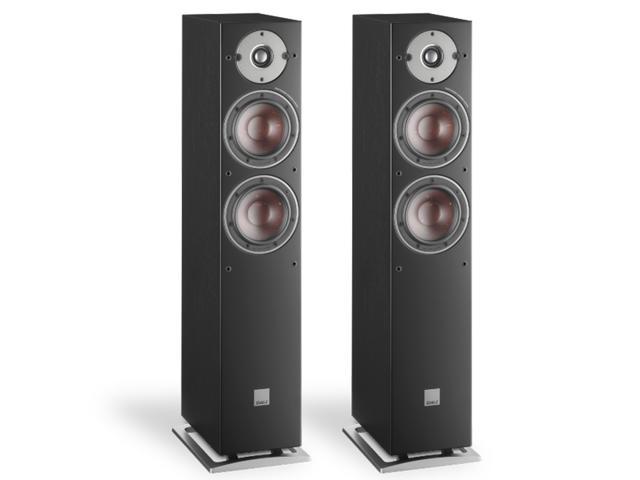
Dali’s Oberon 5 ($1299.00/pr) – The little-speaker-that-could, has been showered with press awards for what it is, and what it is, it is perfectly. Namely, a small floorstander that’s lightning-quick on its feet, pure and even of tone, nicely resolved but not overly so and very coherent. Such are its merits and so well concealed its weaknesses until you listen to a much larger speaker, you rarely notice the things it can’t quite do; like deep bass or huge scale. Easy to drive, dynamic at lower volumes, and easy to place, the Oberon 5’s disappear into a vast soundstage. With the right recording, they have that ‘it’ factor that can put performers in your room along with a certain quietude between the notes that is better heard than described. All this greatness means a speaker I originally bought as a (relatively) inexpensive stopgap has become a long-term reference in my system (David Abramson).

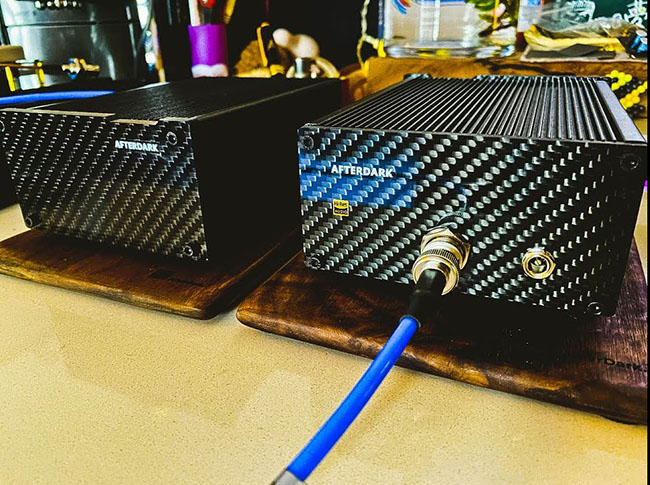
AfterDark Project ClayX Giesmann OCXO 10m Hz Reference Master Clock Emperor Double Crown and Linear Power Supply ($1870)
The “Emperor Double Crown” master clock is said to fall within the sweet spot of the Project ClayX Giesmann OCXO 10m Hz Reference Master Clock line, which consists of 10 models with varying phase noise as measured at 10 and 1 Hz. With the AD Master Clock, I heard much further into the recording with a surprisingly significant increase in microdynamic contrasts and bass articulation. Instruments displayed a greater sense of space and depth within the soundstage and possessed a more natural tone. There was also an added weight to the music while the music took on a greater sense of realism. The AD Master Clock brought me closer to the essence of music with my digital front-end’s sonics transformed in ways not felt with the many past upgrades – some that had much higher price tags. (Mike Girardi)
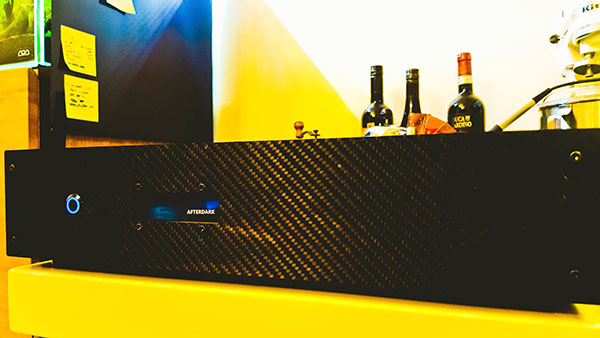
AfterDark Project ClayX Roon Karmann Music Server x Handhartilo Series ($3218)
This handmade Roon Music Server design is a work of art in superior parts selection and implementation that far exceeds the performance of the Roon Nucleus Plus. The fanless Roon Core consists of an Intel i7 Gen10 processor Quad Core 8 Threads (Base Frequency 1.80GHz, Max Turbo Frequency 4.90GHz) 8M Cache, Mircon 32GB DDR4 2666 RAM (34.1 GB/s) (Dual Channels), Samsung 512GB OS M.2 SSD NVME PCIE 4.0, high current version Project ClayX linear power supply, Project ClayX Triple Crown Internal dc cable employing Duelund Silver, Intel 2.4G + 5G WiFi + Bluetooth 4.0, optional SATA SSD drives up to 18 TB, more than 6 simultaneous zones, and all DSP functions available. The chassis is mainly built from carbon fiber being engineered for EMI suppression and anti-resonance. This all results in a digital signal that displays a wall to wall soundstage of vibrant colors against a dead silent deep black backdrop with astounding realism. A significant upgrade to my previous tweaked out reference music server. Review forthcoming. (Mike Girardi)
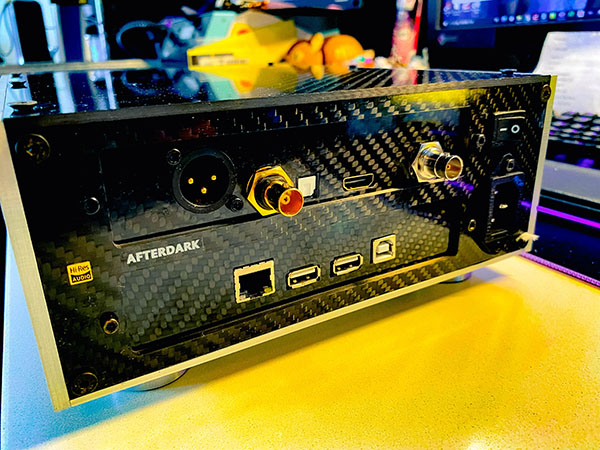
AfterDark Project ClayX Giesemann Rosanna Network Bridge x OCXO 10M Master Clock x Roon Ready ($1328)
Like the AfterDark Project ClayX Roon Karmann Music Server, this unit is a work of art in superior parts selection and implementation. This unit included a custom-built add-on board that allowed the interface and conversion of the AfterDark Project ClayX Roon Karmann Music Server Ethernet output to the I2S digital input on the non-Roon compliant Ayon Audio S-5 Network Player. I was afraid that adding another component in the signal path would raise the noise floor but if the AD Network Bridge raised the noise floor, I couldn’t hear it. The AD Network Bridge using the I2S connection to the Ayon Audio Network Player unlocked the full potential of the internal tube-regulated Ayon DAC and punched far above its price point. The competition in Roon-based interface components will take notice of this newly released device. Review forthcoming. (Mike Girardi)
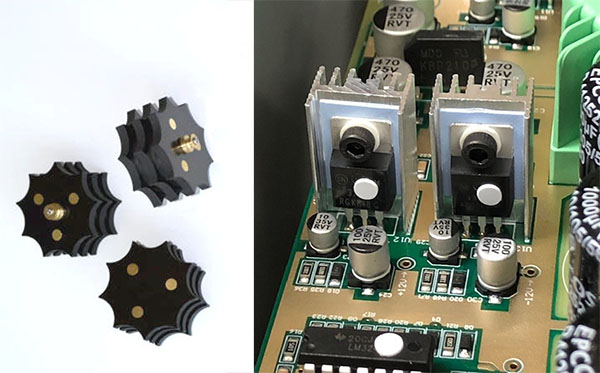
Marigo Audio Lab E3 Mystery Feet and ZSD-41/ZSD-31 SuperDots ($1199, $89, and $59 respectively)
Marigo Audio Lab E3 Mystery Feet are said to be designed from the ground up to be configurable to interface with any equipment’s unique and specific vibrational and resonance characteristics and consist of 96 individual components (total part count in a set of three). E3 Mystery Feet, ZSD-31, and ZSD-41 SuperDots are composed of custom-produced composite materials stacked in a proprietary layer arrangement and are a result of refinement based on numerous iterations and dedicated listening tests. The trio of Marigo Audio Lab products excelled at accurately portraying the interrelationship of space between instruments and the image depth of each instrument. Compared to my previous reference component footers, there was a completeness to the sound such that all frequencies within the response output were treated and improved equally. As I replaced my reference isolation with E3 footers and ZSD SuperDots under each component in my system, the weight of each instrument increased significantly while exposing more of the air of the recording venue. A new standard has been set. (Mike Girardi)
Marigo Audio Lab L3 Isolation Platform and Large Composite Base ($1949 and $199)
The 1.5” thick Marigo Audio Lab L3 Isolation Platform, is the top of the line platform consisting of 40 alternating thin layers of an extremely stiff proprietary custom high-tech composite, which is shaped into a microscopic wave pattern, combined with a unique heat cured resonance damping material. Each L3 platform has a large chamfer machined on the top and bottom perimeter with each chamfer dispersing remaining low level vibrations that can propagate longitudinally within the L3 platform, redirected, traveling at an angle through many constrained layers of the platform, to be dissipated completely. Large Composite Base(s) are similar to the Marigo Audio Lab SuperDots in their construction and functionality (but are larger and thicker) and are typically used under Mystery Feet or under any component requiring state of the art isolation and resonance control. The addition of L3 Platforms and LRCB(s) to my system lowered the noise floor even further than the Marigo Audio Lab E3 Mystery Feet while refining the micro and macro dynamic response. There was a new found coherency in frequency response timing not previously attained in my system when I replaced all butcher block platforms with the E3 Isolation Platform. A new standard has been set in terms of component isolation and resonance control. (Mike Girardi)
Stereo Times Masthead
Publisher/Founder
Clement Perry
Editor
Dave Thomas
Senior Editors
Frank Alles, Mike Girardi, John Hoffman, Russell Lichter, Terry London, Moreno Mitchell, Paul Szabady, Bill Wells, Mike Wright, Stephen Yan, and Rob Dockery
Current Contributors
David Abramson, Tim Barrall, Dave Allison, Ron Cook, Lewis Dardick, Dan Secula, Don Shaulis, Greg Simmons, Eric Teh, Greg Voth, Richard Willie, Ed Van Winkle, and Rob Dockery
Music Reviewers:
Carlos Sanchez, John Jonczyk, John Sprung and Russell Lichter
Site Management Clement Perry
Ad Designer: Martin Perry





